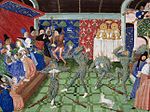Portal:Europe/Featured article/4
The Bal des Ardents was a masquerade ball held on 28 January 1393 in Paris at which Charles VI of France performed in a dance with five members of the French nobility. Four of the dancers were killed in a fire caused by a torch brought in by a spectator, Charles' brother Louis, Duke of Orléans. King Charles and the remaining dancer, the noble knight Ogier de Nantouillet, survived. The ball was one of a number of events intended to entertain the young king, who the previous summer had suffered an attack of insanity. The event undermined confidence in Charles' capacity to rule; Parisians considered it proof of courtly decadence and threatened to rebel against the more powerful members of the nobility. The public's outrage forced the king and his brother Orléans, whom a contemporary chronicler accused of attempted regicide and sorcery, into offering penance for the event.
Charles' wife, Isabeau of Bavaria, held the ball to honor the remarriage of a lady-in-waiting. Scholars believe it may have been a traditional charivari, with the dancers disguised as wild men, mythical beings often associated with demonology, that were commonly represented in medieval Europe and documented in revels of Tudor England. The event was chronicled by contemporary writers such as the Monk of St Denis and Jean Froissart, and illustrated in a number of 15th-century illuminated manuscripts by painters such as the Master of Anthony of Burgundy. The incident later provided inspiration for a scene in Edgar Allan Poe's short story "Hop-Frog".

